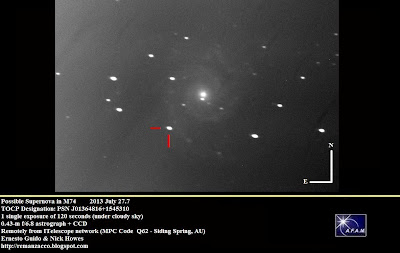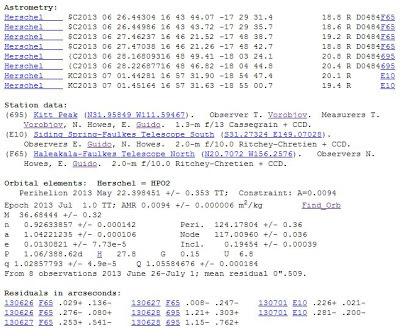M.P.E.C. 2013-O29, issued on 2013 July 20, reports the recovery of the Apollo asteroid 2003 DZ15 (magnitude 18) by F51 Pan-STARRS 1, Haleakala, on images taken on July 19.4 with a 1.8-m Ritchey-Chretien + CCD.
2003 DZ15 was discovered on February 2003 by 608 Haleakala-NEAT/MSSS and it has an estimated size of 95 m - 210 m (based on the object's absolute magnitude H=22.2) and it will have a close approach with Earth at about 9.1 LD (Lunar Distances = ~384,000 kilometers) or 0.0233 AU (1 AU = ~150 million kilometers) at 0037 UT on 2013 July 30. This asteroid will reach the peak magnitude ~16.5 on 29 and 30 July 2013. This is its closest approach to the Earth for this century, although it will make a pass nearly as close to the Earth in 2057 on February 12th.
We performed some follow-up measurements of this object, from the Q62 ITelescope network (Siding Spring, AU) on 2013, July 28.6, through a 0.50-m f/6.8 astrograph + CCD + focal reducer. Below you can see our image, single 120-second exposure, taken with the asteroid at magnitude ~16.6 and moving at ~40.80 "/min. At the moment of the close approach 2003 DZ15 will move at ~52 "/min. Click on the image below to see a bigger version (the asteroid is trailed in the image due to its fast speed).
We performed some follow-up measurements of this object, from the Q62 ITelescope network (Siding Spring, AU) on 2013, July 28.6, through a 0.50-m f/6.8 astrograph + CCD + focal reducer. Below you can see our image, single 120-second exposure, taken with the asteroid at magnitude ~16.6 and moving at ~40.80 "/min. At the moment of the close approach 2003 DZ15 will move at ~52 "/min. Click on the image below to see a bigger version (the asteroid is trailed in the image due to its fast speed).
by Ernesto Guido & Nick Howes








